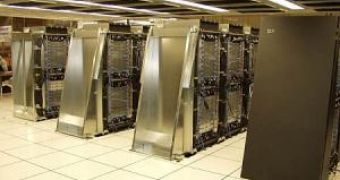IBM has a long standing tradition in building supercomputers and mainframes and lately their machines are likely to be the most powerful computing platforms in the whole world. Until now the most powerful supercomputer was IBM's Blue Gene model L system, but now a new and even more powerful system is on its way. The Blue Water supercomputer is, at least in theory, capable of reaching a petaflop, which means one thousand trillion distinct mathematical operations per second.
As such a supercomputer is not exactly cheap, IBM entered a partnership with the U.S. National Science Foundation which received a green light from the United States' National Science Board to create the $208 million machine at the University of Illinois. The National Center for Supercomputing Applications, or NCSA for short, from the University of Illinois will soon become the home of the Blue Water system. This is the first step toward creating supercomputers that can break the petaflop limit in a viable and sustainable manner, as the IBM Blue Gene model L system has only a third of the computing power that will be available to the Blue Water system.
Blue Water will be constantly kept busy by working with projects from the Defense Advanced Research Projects Agency, or DARPA as it is better known, which is the research arm of the Pentagon. Among other duties that will become Blue Water's day and night activities there are a number of weather modeling programs, biophysics and biochemistry and computer science projects.
Construction of the Blue Water supercomputer will begin shortly, but there are still a number of outside problems that must be sorted. For one thing the entire system will take up quite a bit of space and while there are buildings than can accommodate it, their power lines are not enough for the Blue Water system. Even if building a new location for it may be possible the current funding from the National Science Foundation does not cover the additional expenses.

 14 DAY TRIAL //
14 DAY TRIAL //